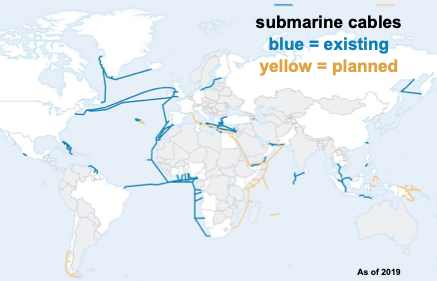submarine cables
 a.k.a. MAREA
a.k.a. MAREA Underwater fiber-optic cables that handle the majority of intercontinental Internet traffic. These large cables are laid along sea-lanes and as close to land as is feasible.
Historical perspective: In September 2017, Facebook and Microsoft finished laying a massive Internet cable across the Atlantic ocean according to TheVerge.com. The cable, called MAREA after the Spanish word for "tide," stretches more than 4,100 miles, from Northern Virginia to Bilbao, Spain. Capable of transmitting 160 terabits of bandwidth per second, it is the highest capacity cable ever to cross the Atlantic. Technology companies are increasingly moving into the infrastructure business to support the massive cloud computing operations that power their services. Google is another tech company that has invested in undersea cables, one stretching from the U.S. to South America and another to Japan and other parts of Asia.
Not to be outdone, since September 2016, China Telecom has replaced satellite stations with 4G fiber-optic cable stations in order to strengthen China’s command and control capabilities in the South China Sea. Over the longer term, China’s cable strategy holds serious security implications for the U.S., Taiwan and the Asia–Pacific community. Undersea fiber-optic cable is the backbone of data transmission and intercontinental communications. A "submarine cable" can transmit the equivalent of the entire printed collection of the Library of Congress in about 20 seconds. In 2014, roughly 98% of emails, telephone calls and internet traffic travelled through underwater cables.


Edit Word